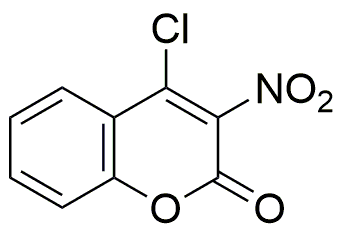4-Chloro-3-nitrocoumarin is widely utilized in research focused on:
- Fluorescent Probes: This compound is used to develop fluorescent probes for biological imaging, allowing researchers to visualize cellular processes in real-time.
- Photodynamic Therapy: It plays a role in photodynamic therapy for cancer treatment, where it can be activated by light to produce reactive oxygen species that kill cancer cells.
- Analytical Chemistry: The compound serves as a reagent in analytical chemistry for detecting various substances, enhancing the sensitivity and specificity of assays.
- Organic Synthesis: It is utilized in organic synthesis as an intermediate for creating other complex molecules, particularly in the pharmaceutical industry.
- Research on Antimicrobial Agents: This chemical is explored for its potential antimicrobial properties, contributing to the development of new antibiotics and disinfectants.
Información general
Propiedades
Seguridad y normativas
Aplicaciones
4-Chloro-3-nitrocoumarin is widely utilized in research focused on:
- Fluorescent Probes: This compound is used to develop fluorescent probes for biological imaging, allowing researchers to visualize cellular processes in real-time.
- Photodynamic Therapy: It plays a role in photodynamic therapy for cancer treatment, where it can be activated by light to produce reactive oxygen species that kill cancer cells.
- Analytical Chemistry: The compound serves as a reagent in analytical chemistry for detecting various substances, enhancing the sensitivity and specificity of assays.
- Organic Synthesis: It is utilized in organic synthesis as an intermediate for creating other complex molecules, particularly in the pharmaceutical industry.
- Research on Antimicrobial Agents: This chemical is explored for its potential antimicrobial properties, contributing to the development of new antibiotics and disinfectants.
Documentos
Hojas de datos de seguridad (HDS)
La SDS proporciona información de seguridad completa sobre la manipulación, el almacenamiento y la eliminación del producto.
Especificación del producto (PS)
La PS proporciona un desglose completo de las propiedades del producto, incluida la composición química, el estado físico, la pureza y los requisitos de almacenamiento. También detalla los rangos de calidad aceptables y las aplicaciones previstas del producto.
Certificados de análisis (COA)
Busque certificados de análisis (COA) ingresando el número de lote del producto. Los números de lote y de partida se pueden encontrar en la etiqueta de un producto después de las palabras "Lote" o "Lote".
Número de catálogo
Número de lote/lote
Certificados de origen (COO)
Este certificado de origen confirma el país en el que se fabricó el producto y también detalla los materiales y componentes utilizados en él y si se deriva de fuentes naturales, sintéticas u otras fuentes específicas. Este certificado puede ser necesario para cumplir con las normativas aduaneras, comerciales y regulatorias.
Número de catálogo
Número de lote/lote
Hojas de datos de seguridad (HDS)
La SDS proporciona información de seguridad completa sobre la manipulación, el almacenamiento y la eliminación del producto.
DownloadEspecificación del producto (PS)
La PS proporciona un desglose completo de las propiedades del producto, incluida la composición química, el estado físico, la pureza y los requisitos de almacenamiento. También detalla los rangos de calidad aceptables y las aplicaciones previstas del producto.
DownloadCertificados de análisis (COA)
Busque certificados de análisis (COA) ingresando el número de lote del producto. Los números de lote y de partida se pueden encontrar en la etiqueta de un producto después de las palabras "Lote" o "Lote".
Número de catálogo
Número de lote/lote
Certificados de origen (COO)
Este certificado de origen confirma el país en el que se fabricó el producto y también detalla los materiales y componentes utilizados en él y si se deriva de fuentes naturales, sintéticas u otras fuentes específicas. Este certificado puede ser necesario para cumplir con las normativas aduaneras, comerciales y regulatorias.


